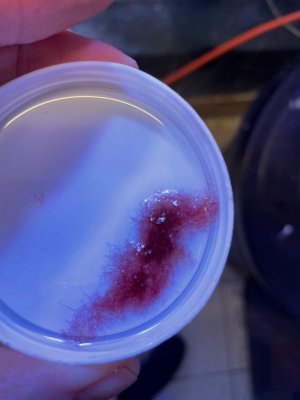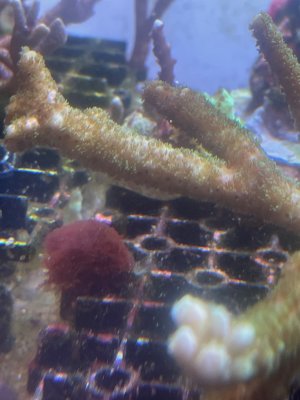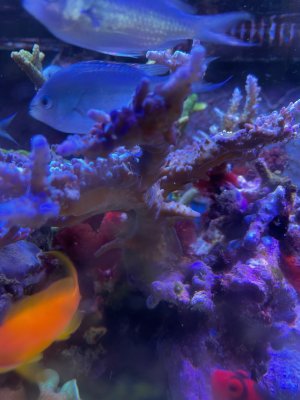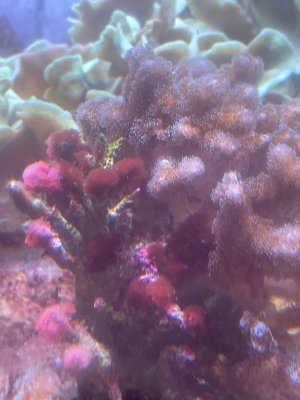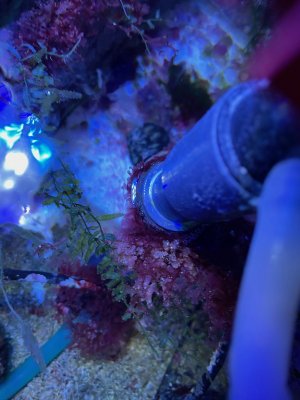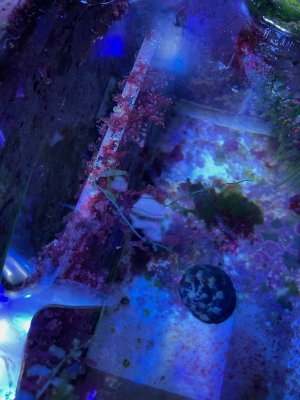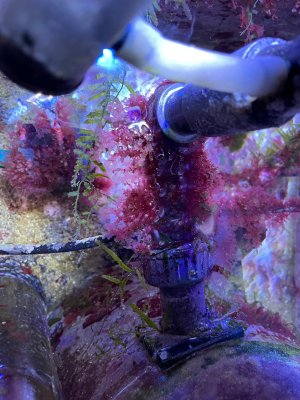Hi all
I'm looking for some practical experience-driven advice on a red algae issue I have had now for several years. After extensive research I believe it is Asparagopsis taxiformis in the sporophyte state (used to be called Falkenbergia hillebrandii.). This is NOT what is often called "pink cotton candy" algae (callithamnion) that can generally be taken care of by a few Mexican turbo snails.
I first posted about this on reef2reef forum in 2021 and much of the situation remains the same 2 years later. I am continuing trying Kent Tech M to weaken the algae tufts and hope my newly added Foxface (siganus vulpinus) will nibble at it. Over the years I have several tried true Mexican turbo snails (which usually due fairly quickly and make a negligible impact). I have even completely stripped my frag system 6 months ago and cleaned it with bleach and then H2O2, but the algae still soon returned on various frag plugs and colonies, probably spread from the sump. The algae happily co-exists with the caulerpa taxifolia in my refugium. So, if anyone has any direct experience of something similar I would greatly appreciate your help. To confirm this is NOT a parameters issue - my PO4 and nitrates are fine, the system is now many years old and stable. I believe this is just a very persistent algae which, because it is red, is less appealing to most herbivores available in the hobby. Many thanks in advance for any suggestions.
Here is the Algae ID thread
Asparagopsis taxiformis - Reef Central Online Community
Here is the thread and what I posted some years ago which still applies.
Battle with red hair algae
For context I am in the UK and have a 2,000 litre system consisting of large established display and interconnected frag tank, sump and refugium. I started seeing tufts of this fluffy reg algae about 6 years ago in my frag take and DT and have been intermittently battling it ever since. It is definitely not cotton candy algae (callithamnion) nor is it classic red turf algae. It is relatively slow growing, very filamentous and a deep red (not pink). It is not brutally invasive but is is very persistent and will "anchor" itself in rock crevices etc, and it appears broken-off filaments will re-establish elsewhere. I have no option to remove rocks completely or drop my water level significantly to spot treat in open air so over the years I have researched and tried various things on terms of treatments and biological control. I have had some moderate success by spot treatment with Kent Tech M Magnesium (a treatment that worked for me years ago to kill bryopsis). I remember reading somewhere that it is possibly the lithium in the formulation weakens the algae rather that the Mg itself. The algae tends to turn brilliant red after spot treatment and then sometimes is eaten by my tangs or foxface. I am also currently trying a side-by-side test of Kent Tech M alongside spot treatment using H2O2 9% to compare impact. I have recently read somewhere that Aiptasia X may kill certain algae and am just now trying that as well. In terms of biological control I have tried several groups of Mexican Turbos with not much success (some large ones and some smaller) plus the snail species. I have blue tuxedo urchins that seem to not do much. I have read that for some reason red tuxedos are more successful so may try that although some of the algae tufts are in the middle of coral colonies or zoas so unlikely an urchin will be able to reach them. Hermits or emerald crabs do very little. So in summary, having over the last 15 years overcome dinos, bryopsis, cyano outbreaks, hydroids, palythoa invasions and all manner of things, this has been my longest struggle (although it is more annoying than an existential threat to the reef). If anyone has any insights or thoughts I would be very grateful - and can post a few pics if anyone is interested.
I'm looking for some practical experience-driven advice on a red algae issue I have had now for several years. After extensive research I believe it is Asparagopsis taxiformis in the sporophyte state (used to be called Falkenbergia hillebrandii.). This is NOT what is often called "pink cotton candy" algae (callithamnion) that can generally be taken care of by a few Mexican turbo snails.
I first posted about this on reef2reef forum in 2021 and much of the situation remains the same 2 years later. I am continuing trying Kent Tech M to weaken the algae tufts and hope my newly added Foxface (siganus vulpinus) will nibble at it. Over the years I have several tried true Mexican turbo snails (which usually due fairly quickly and make a negligible impact). I have even completely stripped my frag system 6 months ago and cleaned it with bleach and then H2O2, but the algae still soon returned on various frag plugs and colonies, probably spread from the sump. The algae happily co-exists with the caulerpa taxifolia in my refugium. So, if anyone has any direct experience of something similar I would greatly appreciate your help. To confirm this is NOT a parameters issue - my PO4 and nitrates are fine, the system is now many years old and stable. I believe this is just a very persistent algae which, because it is red, is less appealing to most herbivores available in the hobby. Many thanks in advance for any suggestions.
Here is the Algae ID thread
Asparagopsis taxiformis - Reef Central Online Community
| ormis - Reef Central Online Community Asparagopsis taxiformis Marine Plants & Macroalgae www.reefcentral.com |
Here is the thread and what I posted some years ago which still applies.
Battle with red hair algae
 | Battle with red hair algae Hi guys, I’m new to the forum. I am from South Africa and have been reefing for the better part of 5 years. I’ve run into some issues and would like some advice. I have some red hair algae that I have been battling. I assume it was a bit of negligence on my side and throwing in some high tds... www.reef2reef.com |
For context I am in the UK and have a 2,000 litre system consisting of large established display and interconnected frag tank, sump and refugium. I started seeing tufts of this fluffy reg algae about 6 years ago in my frag take and DT and have been intermittently battling it ever since. It is definitely not cotton candy algae (callithamnion) nor is it classic red turf algae. It is relatively slow growing, very filamentous and a deep red (not pink). It is not brutally invasive but is is very persistent and will "anchor" itself in rock crevices etc, and it appears broken-off filaments will re-establish elsewhere. I have no option to remove rocks completely or drop my water level significantly to spot treat in open air so over the years I have researched and tried various things on terms of treatments and biological control. I have had some moderate success by spot treatment with Kent Tech M Magnesium (a treatment that worked for me years ago to kill bryopsis). I remember reading somewhere that it is possibly the lithium in the formulation weakens the algae rather that the Mg itself. The algae tends to turn brilliant red after spot treatment and then sometimes is eaten by my tangs or foxface. I am also currently trying a side-by-side test of Kent Tech M alongside spot treatment using H2O2 9% to compare impact. I have recently read somewhere that Aiptasia X may kill certain algae and am just now trying that as well. In terms of biological control I have tried several groups of Mexican Turbos with not much success (some large ones and some smaller) plus the snail species. I have blue tuxedo urchins that seem to not do much. I have read that for some reason red tuxedos are more successful so may try that although some of the algae tufts are in the middle of coral colonies or zoas so unlikely an urchin will be able to reach them. Hermits or emerald crabs do very little. So in summary, having over the last 15 years overcome dinos, bryopsis, cyano outbreaks, hydroids, palythoa invasions and all manner of things, this has been my longest struggle (although it is more annoying than an existential threat to the reef). If anyone has any insights or thoughts I would be very grateful - and can post a few pics if anyone is interested.

